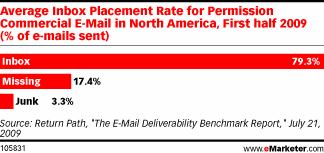More than one way to miss the mark
AUGUST 7, 2009 – E-mail marketers are used to seeing reported delivery rates around 95%. However, data from Return Path, an e-mail services company, indicates they may be missing the hard truth.
Hard bounces, which are admittedly rare, are not the only reason for nondelivery of e-mail. ISP and corporate filtering systems quietly weed out messages without informing the sender. Some messages end up in bulk or spam folders, while others are, according to Return Path, “completely missing.”
In all, Return Path found 79.3% of permission e-mail messages made it to inboxes in North America in the first half of 2009.

In the US alone, the inbox placement rate was slightly higher, at 82%.
It was even more difficult for e-mail marketers to reach business subscribers. Only 72.4% of business-to-business (B2B) e-mails were delivered to inboxes.

Successful delivery rates varied widely by ISP. In the US, Gmail subscribers were hardest to reach, with a 23% failure rate. Hotmail and MSN were close behind, at 20% each.

Why are failure rates so high�and why haven�t e-mail marketers noticed? One reason could be e-mail�s high ROI, which masks the problem.
“Many marketers are still resistant to implementing the best practices that make email deliverability more likely and more consistent,” wrote the report�s authors. “We still see programs with high frequency, low value and lack of segmentation.”
Welcome messages, efficient opt-out procedures and appropriate permission levels are all best practices recommended by Return Path.
About eMarketer
By gathering the latest research and news from over 1,000 sources, eMarketer has established itself as the world’s leading provider of internet and e-business statistics. eMarketer’s Web site is at www.emarketer.com.


